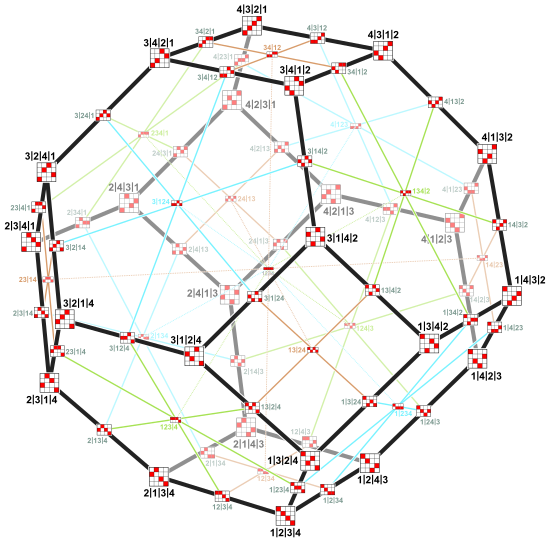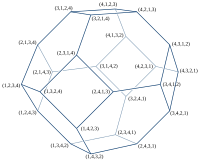利用者:青子守歌/ワークスペース3
| このページは青子守歌が作業スペースとして利用しているページです。作業中の場合、どこかの記事から転記されていることがありますが、このページはその記事と同期をとっているわけではないので注意してください。また、調べ物の参考にはまったくならないので注意してください。 |

- 頂点
- 座標が(1,2,3,4)の置換となっており、頂点に描かれた4桁の数字がその頂点の4次元空間上の座標を示す(例:4312は座標4次元空間上の座標で(4,3,1,2)にある頂点)
- 辺
- 両端の頂点座標が値1だけ違う要素が1箇所だけ入れ替わった点になっており、辺の色は右下の凡例で太線になっている箇所が入れ替わっていることを示す(例:4312と3412を張る辺は、3と4という値が1だけ違う要素を入れ替えており、その位置は0,1番目であるため凡例に対応する色は青色になっている)。定義から、平行な辺が同じ色となり、4要素であるので6色存在する
置換多面体(ちかんためんたい、フランス語: permutoèdre、英語: permutohedron)とは、超多面体の1種。特にn次置換多面体とは、以下のようなn-1次元(超)多面体がn次元空間に埋め込まれた超多面体を指す。
歴史
[編集]この節の加筆が望まれています。 |
Günter M. Ziegler (1995)によると、置換多面体を最初に研究したのはPieter Hendrik Schoute (1911)である。この多面体にpermutoèdreと名付けたのはGeorges Th. Guilbaud and Pierre Rosenstiehl (1963)である。この名付けについて著者らは、読者への反論として「粗野ではあるが覚えやすい」[1]と回答している。
英語ではpermutahedronと綴ることもある[2]。またpermutation polytopesと呼ばれることもあるが、この表記はもっぱらバーコフ多面体(英語: Birkhoff polytope)において置換行列の凸包として定義される場合に用いられる。広義には、ある集合の置換と全単射な頂点を持つ任意の超多面体のことを指すこともあるV. Joseph Bowman (1972)。
頂点と辺と面
[編集]| 頂点, 辺, ファセット, 面 面の次元:d = n − k. |
k = 1 2 3 4 5 n 1 1 1 2 1 2 3 3 1 6 6 13 4 1 14 36 24 75 5 1 30 150 240 120 541 |
n次の置換多面体において、頂点はn!個存在し、n − 1個との点と接続されている。
また、辺は(n − 1) n!/2個存在し、その長さは√2である。 辺が接続するのは、値が1異なる2つの座標軸の値を入れ替えた2点であり[3]、この時入れ替えた座標軸が、辺の方向となる。
ファセットは2n − 2個存在する({1 … n}の空でない真部分集合Sと対応するため)。 部分集合Sに対応するファセットの頂点は共通しており、その頂点のSにおける座標は、S以外に対応するファセットの頂点座標より小さい[4]。
より一般的に言えば、0次元面(頂点)からn − 1次元面(置換多面体そのもの)までが、集合{1 … n}の狭義弱順序(英語: strict weak ordering)となる。 よって、全ての面の数は、n番目の順序ベル数(英語: ordered Bell number)となる[5]。 また、次元dの面は、k = n − dの同値類の順序と一致する。
n次の置換多面体にあるd = n − k次元の面は、三角形T(オンライン整数列大辞典の数列 A019538)となり、
である。 ここに、は第2種スターリング数である。 この値の例を、右の表に、行の合計値と順序ベル数とともに示す。
| 3次 | 4次 | ||||
|---|---|---|---|---|---|

|

| ||||
上記の画像は、3次および4次置換多面体の面格子(英語: face lattice)を図示したものである(空でない面のみ)。 各面の中心点は狭義弱順序を示す(例えば、4次において面の中心に3 4 | 1 2と描かれている場合、それは({3, 4}, {1, 2})の意味)。 その順序は分割細分(英語: partition refinement)によって半順序となっており、細かい分割が外側になっている。 面格子上の辺(置換多面体上ではないことに注意)に沿って進行すると、2つの隣接した同値類を統合することと等価となる。 頂点に示されるa | b | c | dは、順列(a, b, c, d)を表し、ケイリーグラフを構成する。
| |||||
Other properties
[編集]
The permutohedron is vertex-transitive: the symmetric group Sn acts on the permutohedron by permutation of coordinates.
The permutohedron is a zonotope; a translated copy of the permutohedron can be generated as the Minkowski sum of the n(n − 1)/2 line segments that connect the pairs of the standard basis vectors .[6]
The vertices and edges of the permutohedron are isomorphic to one of the Cayley graphs of the symmetric group, namely the one generated by the transpositions that swap consecutive elements. The vertices of the Cayley graph are the inverse permutations of those in the permutohedron.[7] The image on the right shows the Cayley graph of S4. Its edge colors represent the 3 generating transpositions: (1, 2), (2, 3), (3, 4)
This Cayley graph is Hamiltonian; a Hamiltonian cycle may be found by the Steinhaus–Johnson–Trotter algorithm.
Tessellation of the space
[編集]The permutohedron of order n lies entirely in the (n − 1)-dimensional hyperplane consisting of all points whose coordinates sum to the number
- 1 + 2 + … + n = n(n + 1)/2.
Moreover, this hyperplane can be tiled by infinitely many translated copies of the permutohedron. Each of them differs from the basic permutohedron by an element of a certain (n − 1)-dimensional lattice, which consists of the n-tuples of integers that sum to zero and whose residues (modulo n) are all equal:
- x1 + x2 + … + xn = 0, x1 ≡ x2 ≡ … ≡ xn (mod n).
This is the lattice , the dual lattice of the root lattice . In other words, the permutohedron is the Voronoi cell for . Accordingly, this lattice is sometimes called the permutohedral lattice.[8]
Thus, the permutohedron of order 4 shown above tiles the 3-dimensional space by translation. Here the 3-dimensional space is the affine subspace of the 4-dimensional space R4 with coordinates x, y, z, w that consists of the 4-tuples of real numbers whose sum is 10,
- x + y + z + w = 10.
One easily checks that for each of the following four vectors,
- (1,1,1,−3), (1,1,−3,1), (1,−3,1,1) and (−3,1,1,1),
the sum of the coordinates is zero and all coordinates are congruent to 1 (mod 4). Any three of these vectors generate the translation lattice.
The tessellations formed in this way from the order-2, order-3, and order-4 permutohedra, respectively, are the apeirogon, the regular hexagonal tiling, and the bitruncated cubic honeycomb. The dual tessellations contain all simplex facets, although they are not regular polytopes beyond order-3.
Examples
[編集]| Order 2 | Order 3 | Order 4 | Order 5 | Order 6 |
|---|---|---|---|---|
| 2 vertices | 6 vertices | 24 vertices | 120 vertices | 720 vertices |

|

|

|

|

|
| line segment | hexagon | truncated octahedron | omnitruncated 5-cell | omnitruncated 5-simplex |
See also
[編集]Notes
[編集]- ^ 原文(フランス語):"le mot permutoèdre est barbare, mais il est facile à retenir; soumettons-le aux critiques des lecteurs."
- ^ Thomas (2006)
- ^ Gaiha & Gupta (1977)
- ^ Lancia (2018), p. 105(The Permutahedronの章).
- ^ See, e.g., Ziegler (1995), p. 18.
- ^ Ziegler (1995), p. 200.
- ^ This Cayley graph labeling is shown, e.g., by Ziegler (1995).
- ^ Baek, Jongmin; Adams, Andrew (2009). “Some Useful Properties of the Permutohedral Lattice for Gaussian Filtering”. Tech. Rep. (Stanford University).
References
[編集]- Bowman, V. Joseph (1972), “Permutation polyhedra”, SIAM Journal on Applied Mathematics 22 (4): 580–589, doi:10.1137/0122054, JSTOR 2099695, MR0305800.
- Gaiha, Prabha; Gupta, S. K. (1977), “Adjacent vertices on a permutohedron”, SIAM Journal on Applied Mathematics 32 (2): 323–327, doi:10.1137/0132025, JSTOR 2100417, MR0427102.
- Guilbaud, Georges Th.; Rosenstiehl, Pierre (1963), “Analyse algébrique d'un scrutin”, Mathématiques et Sciences Humaines 4: 9–33.
- Lancia, Giuseppe (2018), Compact extended linear programming models, Cham, Switzerland: Springer, ISBN 978-3-319-63975-8.
- Schoute, Pieter Hendrik (1911), “Analytic treatment of the polytopes regularly derived from the regular polytopes”, Verhandelingen der Koninklijke Akademie van Wetenschappen Te Amsterdam 11 (3): 87 pp Googlebook, 370–381 Also online on the KNAW Digital Library at http://www.dwc.knaw.nl/toegangen/digital-library-knaw/?pagetype=publDetail&pId=PU00011495
- Thomas, Rekha R. (2006), “Chapter 9. The Permutahedron”, Lectures in Geometric Combinatorics, Student Mathematical Library: IAS/Park City Mathematical Subseries, 33, American Mathematical Society, pp. 85–92, ISBN 978-0-8218-4140-2.
- Ziegler, Günter M. (1995), Lectures on Polytopes, Springer-Verlag, Graduate Texts in Mathematics 152.
Further reading
[編集]- Le Conte de Poly-Barbut, Cl. (1990), “Le diagramme du treillis permutoèdre est intersection des diagrammes de deux produits directs d'ordres totaux”, Mathématiques, Informatique et Sciences Humaines 112: 49–53.
- Santmyer, Joe (2007), “For all possible distances look to the permutohedron”, Mathematics Magazine 80 (2): 120–125, doi:10.1080/0025570X.2007.11953465
External links
[編集]- Bryan Jacobs. "Permutohedron". mathworld.wolfram.com (英語).
- Alexander Postnikov (2005). "Permutohedra, associahedra, and beyond". arXiv:math.CO/0507163。













